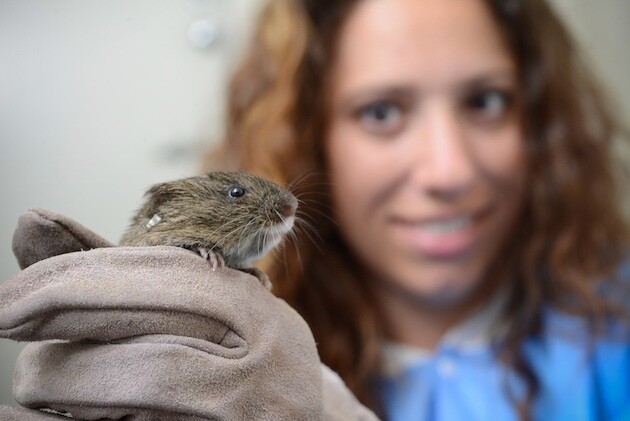Cute Rodent, Once Thought Extinct, Going Home Next Week

An endangered species of vole that scientists once thought had gone extinct will be going through a rite of passage next week, as biologists release some of the wild voles' captive-bred progeny back into their natural desert wetland habitat.
The Amargosa vole, Microtus californicus scirpensis, hangs on in just a few patches of wetland outside Death Valley near the Inyo County town of Tecopa. Considered one of North America's most critically endangered mammals, the voles were actually thought to have died out until a state biologist rediscovered the species in 1970.
In 2014 a team of wildlife ecologists captured 20 of the tiny mammals and took them to a laboratory at UC Davis, in the hopes of establishing a captive breeding program to rebuild their numbers. The scientists now have about 90 voles in captivity, some of which will be released next week to see how they fare in their native habitat.
Some of the more than two dozen voles slated to be released will be placed in a bulrush marsh currently occupied by a few other voles, while the rest will go to a different wetland nearby that's not known to have an existing vole population. The voles will be outfitted with tiny radio transmitters so that scientists can keep tabs on their progress. Both of the patches of wetland that will receive the voles have fared well even despite the drought, and the captive breeding team describes the patches as "high-quality" habitat.
That's not the case for a lot of the Amargosa vole's historic range: threats from groundwater pumping and oil runoff to off-road vehicle incursions have damaged the marshes, as well as the bulrushes in them; aquatic, grasslike plants that the voles use for shelter and food.
"We plan to monitor this first release, make any changes that we need, and continue with releases to bolster the populations in the wild," said Deana Clifford in a press release. Clifford, a wildlife veterinarian with the California Department of Fish and Wildlife and assistant clinical professor at UC Davis, is co-lead of the captive breeding program for the voles.
"Our committed team of collaborators is also carefully monitoring the health of the marshes these voles depend on," added Clifford. "We're trying to restore an important, but degraded marsh so that, unlike their parents, these voles can thrive in their natural habitat."
"We didn't know much about these little guys when we started -- how long it would take a captive population to build, whether they'd survive, learn to eat, know how to raise pups, or their optimal breeding conditions," said Clifford's colleague Janet Foley of the UC Davis School of Veterinary Medicine. "We've learned a lot in the past few months about their population genetics, basic ecology and behavior. Fortunately, they've been great breeders."
Along with U.C. Davis and CDFW, the breeding project is being supported by the Bureau of Land Management, U.S. Fish and Wildlife Service, the state Office of Emergency Services, and the village of Shoshone.
The voles are scheduled for release into their new homes early next week. Be fruitful and multiply, little guys.




